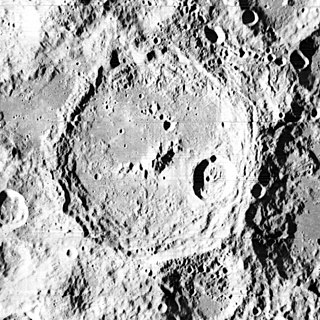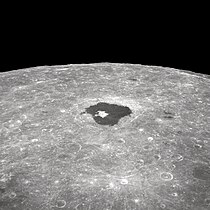
Mare Nectaris is a small lunar mare or sea located south of Mare Tranquillitatis southwest of Mare Fecunditatis, on the near side of the Moon. Montes Pyrenaeus borders the mare to the east and Sinus Asperitatis fuses to its northwestern edge. It is 84,000 square kilometers in size.

Arzachel is a relatively young lunar impact crater located in the highlands in the south-central part of the visible Moon, close to the zero meridian. It lies to the south of the crater Alphonsus, and together with Ptolemaeus further north the three form a prominent line of craters to the east of Mare Nubium. The smaller Alpetragius lies to the northwest, and Thebit is to the southwest along the edge of the mare.

Aristoteles is a lunar impact crater that lies near the southern edge of the Mare Frigoris and to the east of the Montes Alpes mountain range. It was officially named in 1935 after the ancient Greek philosopher Aristotle by the International Astronomical Union, using the classical form of his name.

Plinius is a prominent lunar impact crater on the border between Mare Serenitatis to the north and Mare Tranquilitatis to the south. Its diameter is 41 km. The crater is named after the Roman natural scientist and author Pliny the Elder. To the south-southeast of Plinius is the crater Ross, and to the northeast is Dawes. Just to the north is a system of rilles named the Rimae Plinius and touching it is the Brackett crater which is more than a crater diameter north. At the northwest edge of the rille is the Promontorium Archerusia, a cape off the western rim that encloses the Mare Serenitatis.

Brayley is a lunar impact crater located in the southwest part of the Mare Imbrium. It was named after British geographer Edward W. Brayley in 1935. It has a circular rim and a low rise in the center. There are no notable craters overlapping the rim or interior. The sinuous rille Rima Brayley passes to the north of Brayley.

Plato is a lava-filled lunar impact crater on the Moon. Its diameter is 101 km. It was named after ancient Greek philosopher Plato. It is located on the northeastern shore of the Mare Imbrium, at the western extremity of the Montes Alpes mountain range. In the mare to the south are several rises collectively named the Montes Teneriffe. To the north lies the wide stretch of the Mare Frigoris. East of the crater, among the Montes Alpes, are several rilles collectively named the Rimae Plato.

Aitken is a large lunar impact crater that lies on the far side of the Moon, named for Robert Grant Aitken, an American astronomer specializing in binary stellar systems. It is located to the southeast of the crater Heaviside, and north of the unusual formation Van de Graaff. Attached to the southwest rim is Vertregt. To the southeast is the smaller Bergstrand.

Petavius is a large lunar impact crater located to the southeast of the Mare Fecunditatis, near the southeastern lunar limb. Attached to the northwest rim is the smaller crater Wrottesley. To the southeast are Palitzsch, Vallis Palitzsch, and Hase. Farther to the north is the large crater Vendelinus. Petavius appears oblong when viewed from the Earth due to foreshortening. Petavius is Imbrian in age.

Diophantus is a lunar impact crater that lies in the southwestern part of the Mare Imbrium, named after the ancient Greek mathematician Diophantus. It forms a pair with the larger crater Delisle to the north, has a wide inner wall and a low central rise. To the north of Diophantus is the sinuous rille designated Rima Diophantus, named after the crater. Diophantus C lies near the exterior of the southwest wall.

Lansberg is a lunar impact crater on the Mare Insularum. It can be located by following a line south-southwest from Copernicus to Reinhold, then southwest to Lansberg. The crater has a high rim and a central mountain. There are terraces along the inner walls, and the tops have slumped to produce a sharp edge. This formation is not noticeably eroded, and there are no significant impact craters within the interior.

Vitruvius is a small lunar impact crater that lies on the northern edge of the Mare Tranquillitatis. To the east is the crater Gardner, and to the northeast is Fabbroni. To the north-northwest is the elongated Mons Vitruvius mountain, and beyond is the valley where the Apollo 17 mission landed.

Milne is a large lunar crater that is located in the southern hemisphere on the far side of the Moon, named after the British mathematician and astrophysicist Edward Arthur Milne. It lies to the northeast of the Mare Australe, and southeast of Lacus Solitudinis.

Macrobius is a prominent lunar impact crater located to the northwest of the Mare Crisium. Its diameter is 63 km. It was named after ancient Roman writer Macrobius. It lies on the southeast edge of the Lacus Bonitatis, a small lunar mare. The somewhat smaller crater Tisserand lies just to the east.

Fermi is a large lunar impact crater of the category named a walled plain. It was named after Italian-American physicist and Nobel laureate Enrico Fermi. It lies on the far side of the Moon and can not be viewed from the Earth. Thus this feature must be viewed from an orbiting spacecraft.

Mendeleev is a large lunar impact crater that is located on the far side of the Moon, as seen from the Earth. The southern rim of this walled plain just crosses the lunar equator. Intruding into the eastern rim of Mendeleev is the crater Schuster. Nearly on the opposite side, the smaller Hartmann intrudes into west-southwestern rim.

Chauvenet is a lunar impact crater that is located to the northeast of the prominent crater Tsiolkovskiy on the far side of the Moon. Less than one crater diameter to the northwest of Chauvenet is the crater Ten Bruggencate.

Dobrovolʹskiy is a small lunar impact crater on the Moon's far side. The northwest part of its rim is intruded upon by the somewhat larger crater Shirakatsi, and the outer rampart of that feature covers most of the interior floor of Dobrovolʹskiy. Very little of the original floor now survives, with a small section near the southern inner wall. The remainder of the crater rim is somewhat circular and only mildly worn.

Keeler is a large lunar impact crater that lies on the Moon's far side. It is connected along the eastern edge to Heaviside, a walled plain of similar dimensions. Keeler, however, is the younger of the two formations, with more clearly delineated features. To the northeast of Keeler is the smaller crater Stratton, and to the northwest lies Ventris.

Neujmin is a lunar impact crater on the Moon's far side. It is nearly attached to the west-southwest of the smaller crater Waterman, and lies to the southwest of the prominent Tsiolkovskiy.

Waterman is a lunar impact crater that is located on the Moon's far side, and cannot be viewed directly from the Earth. It lies along the southern outer ramparts of the prominent crater Tsiolkovskiy. Almost attached to the southwest is Neujmin, so that Waterman lies straddled between these two features.


























